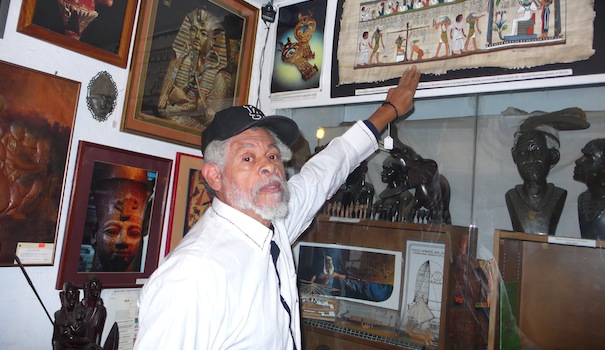Proudly inviting visitors to “experience 6,000 years of African world history”, the African Museum Casa del Rey Moro is located at 2471 Congress Street in San Diego, California. Its content is centered upon the past and present of the Africa Diaspora. It has an emphasis on African-American, African-Mexican and African-Spanish heritages.
Founded by septuagenarian Chuck Ambers more than twenty years ago, the selection of the museum’s site was intentional. Located in the historic Old Town, Ambers started the African Museum Casa del Ray Moro to preserve and promote global Black culture.
Another primary reason for its founding was because he wanted to incorporate Black history that has all too often been purposely omitted from schools and the public. Ambers knew this experience personally as he taught in the elementary schools of Chula Vista for more than thirty years.
His idea and belief that he could even found the African Museum Casa del Ray Moro was inspired by Dr. Charles Wright. Wright’s mission to curate, protect and promote Black culture actually originated in his home in Detroit, Michigan in 1965. Over the next five decades, his efforts have culminated to form the Charles H. Wright Museum, one of the most prominent institutions of Africa Diaspora culture in the United States. It is said to hold the largest permanent collection on African-American culture in the world!
A native of Detroit, Michigan, Ambers’ family was one of the first to support Dr. Wright and his up-and-coming museum. Ambers, as a young man, was inspired by this audacious act and the determination of this brilliant, Black obstetrician-gynecologist.
Ambers left the Midwest to play basketball at MiraCosta Community College in San Diego. He then earned his bachelor’s and master’s degrees as well as a credential to teach. In his time off every summer, he began to travel to Africa, the Americas and Europe. On these visits, he collected artifacts and materials, bringing them back home with him. He soon started using them in his lectures as well as presenting, à la one-man-show, as a person in history. These persons included a Buffalo Soldier and Pio Pico, an African-Mexican governor of California.
Ambers, involved in community affairs, was a member of a committee to open a museum dedicated to Black culture. The proposed site was the Douglas Hotel. Regarded as an icon of the Black community in San Francisco, jazz greats, including Edward Kennedy “Duke” Ellington and Billie Holiday, had performed there.
However, the plans fell through, failing to open in 1994 in San Diego, which at that time was the eighth largest city in the United States. Ambers took matters into his own hands. He purchased a property on Congress Street, opened his museum and retired from teaching. In “Little-known Museum a 15-year Labor of Love” by John Wilkens in the San Diego Union-Tribune, Ambers proudly proclaimed, “I worked for 30 years as a teacher, five days a week, seven hours a day and I got paid … Now I work six days a week, 8 to 10 hours a day and I don’t always get paid. But this is love. You can’t measure love.”
Chuck Ambers’ research and travels, including to ten African countries, have made available to the public diverse materials such as carvings, charts, images, statues, timelines and weavings.
The museum is open daily, from 10:30 a.m. until 7:00 p.m. It has a small gift shop and there are other items possibly available for purchase.
Visitors to the African Museum Casa del Rey Moro will experience, as per its website:
- “The Research Center – Consists of 6000 books in nine languages, 8000 slides in twenty-six presentations, 400 audio-video tapes, countless articles, essays and master-doctorate theses addressing six thousand years of African history.
- The Traveling Exhibit Program – Features seven interactive exhibits with study guides. Traveling exhibits are available for short or long-term rental periods in your facility.
- The Bookstore – Provides a variety of local & international educational, historical, and cultural publications, charts, posters and other materials for purchase, and offers out-of-print and hard to find materials.
- The Tour Service – Consists of local, national and international educational and heritage trips. Local tours are personally conducted to show the African and African-American history in Old Town, San Diego county’s gold-rush country and the Buffalo Soldiers experience. International tours to African and Latin American countries are available.
- The Gift Shop – Souvenirs as well as museum quality items are for sale. Many of the artifacts and fine art graphics are personally framed.
- Internet Retrieval System – The Internet can search thousands of African Heritage centers throughout the Diaspora in a multitude of languages, or contact African-American Genealogical Societies, African-American Museum Associations, and Historically Black Colleges and Universities across the U.S., and around the world.”
